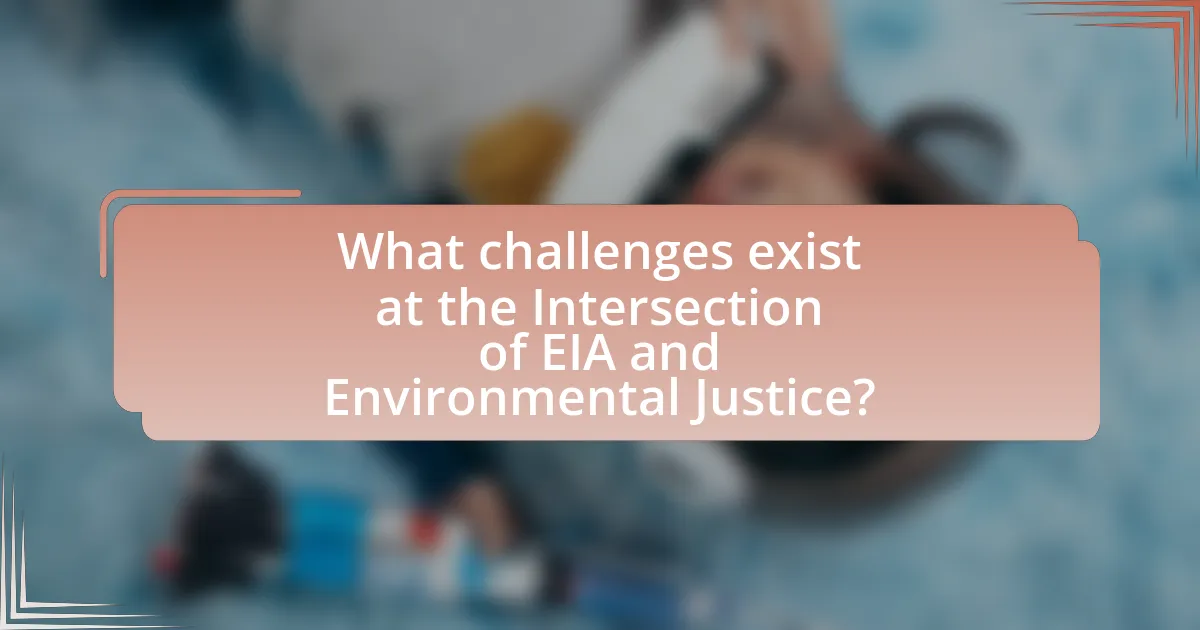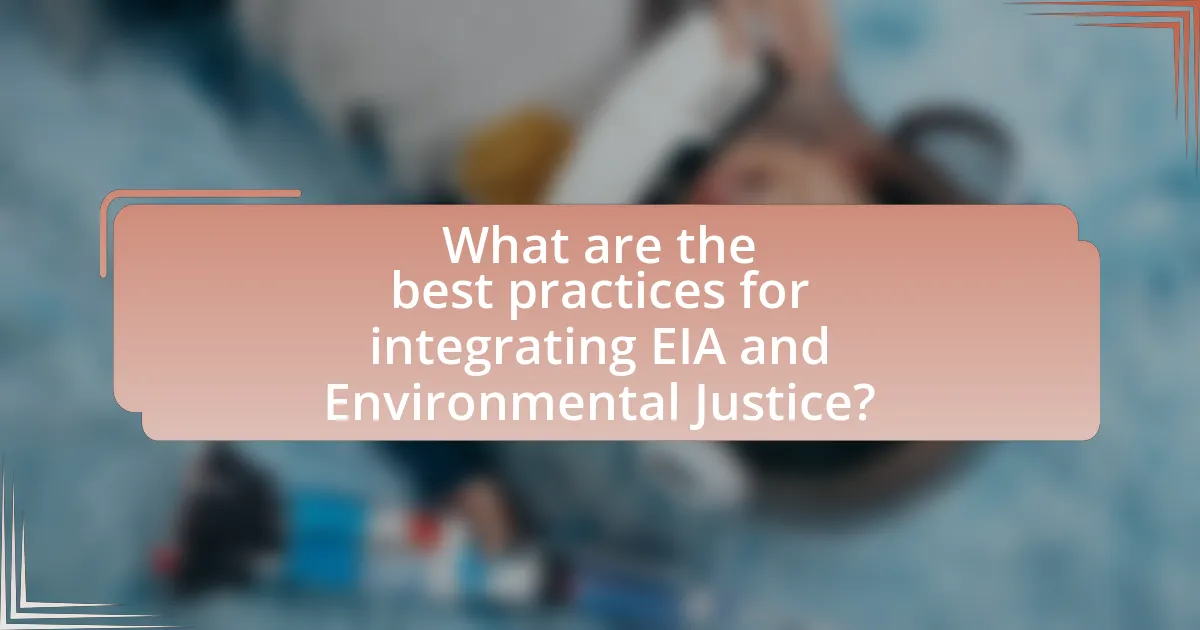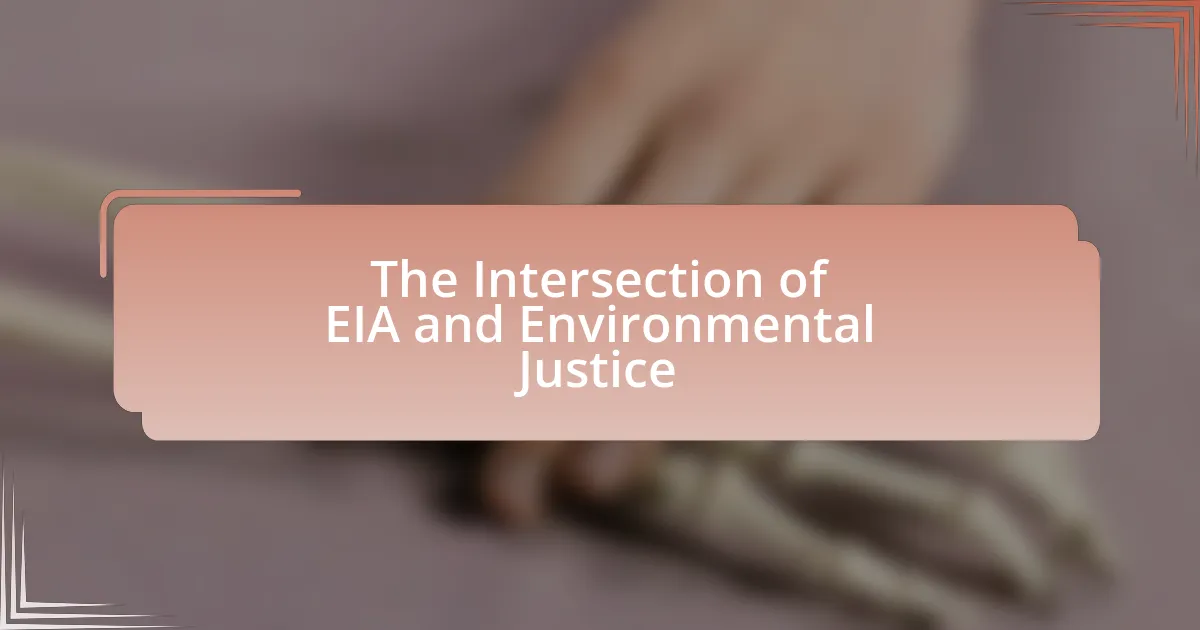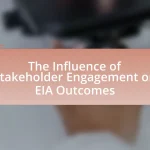The article examines the intersection of Environmental Impact Assessment (EIA) and Environmental Justice, emphasizing the importance of integrating social equity considerations into the EIA process. It highlights how EIAs evaluate potential environmental effects of projects while ensuring that marginalized communities are not disproportionately impacted by environmental hazards. Key principles of EIAs, such as public participation and the assessment of alternatives, are discussed, along with the influence of Environmental Justice on decision-making. The article also addresses challenges and barriers to effective integration, the role of socio-economic factors, and best practices for enhancing community engagement and equitable outcomes in environmental governance.

What is the Intersection of EIA and Environmental Justice?
The intersection of Environmental Impact Assessment (EIA) and Environmental Justice lies in the integration of social equity considerations into the EIA process. EIA aims to evaluate the potential environmental effects of proposed projects, while Environmental Justice focuses on ensuring that marginalized communities are not disproportionately affected by environmental hazards. Research indicates that incorporating Environmental Justice principles into EIA can lead to more equitable decision-making, as seen in the U.S. National Environmental Policy Act, which mandates consideration of environmental impacts on all communities. This integration helps to address historical inequities and promotes inclusive participation in environmental governance.
How do Environmental Impact Assessments (EIA) relate to Environmental Justice?
Environmental Impact Assessments (EIA) are critical tools that help ensure environmental justice by evaluating the potential effects of proposed projects on communities, particularly marginalized groups. EIAs aim to identify and mitigate adverse environmental impacts, which often disproportionately affect low-income and minority populations, thereby promoting equitable treatment and meaningful involvement in environmental decision-making processes. Research indicates that effective EIAs can lead to better outcomes for vulnerable communities by incorporating their input and addressing their specific concerns, as highlighted in the 2018 report by the United Nations Environment Programme, which emphasizes the importance of public participation in achieving environmental justice.
What are the key principles of Environmental Impact Assessments?
The key principles of Environmental Impact Assessments (EIAs) include the assessment of potential environmental effects, public participation, and the consideration of alternatives. EIAs aim to identify, predict, and evaluate the environmental impacts of proposed projects before decisions are made, ensuring that environmental factors are integrated into the planning process. Public participation is crucial, as it allows stakeholders to voice concerns and contribute to the decision-making process, enhancing transparency and accountability. Additionally, evaluating alternatives helps in identifying less harmful options, promoting sustainable development. These principles are supported by regulations in many countries, such as the National Environmental Policy Act (NEPA) in the United States, which mandates EIAs for federal projects.
How does Environmental Justice influence the EIA process?
Environmental Justice significantly influences the Environmental Impact Assessment (EIA) process by ensuring that marginalized communities have a voice in decision-making regarding projects that may affect their environment and health. This influence manifests through the incorporation of community input, which helps identify potential adverse impacts on vulnerable populations, thereby promoting equitable distribution of environmental benefits and burdens. For instance, the National Environmental Policy Act (NEPA) mandates public participation, which aligns with Environmental Justice principles by requiring that affected communities are informed and engaged in the EIA process. This engagement can lead to modifications in project design or implementation to mitigate negative impacts on these communities, thereby reinforcing the importance of social equity in environmental governance.
Why is the Intersection of EIA and Environmental Justice important?
The intersection of Environmental Impact Assessment (EIA) and Environmental Justice is important because it ensures that marginalized communities have a voice in decision-making processes regarding environmental policies and projects that affect their lives. This intersection addresses the disproportionate environmental burdens faced by these communities, as evidenced by studies showing that low-income and minority populations often live near hazardous waste sites and suffer from higher rates of pollution-related health issues. By integrating environmental justice principles into EIA processes, policymakers can promote equitable distribution of environmental benefits and burdens, thereby fostering social equity and protecting vulnerable populations from environmental harm.
What are the potential consequences of neglecting Environmental Justice in EIA?
Neglecting Environmental Justice in Environmental Impact Assessments (EIA) can lead to significant social and environmental inequities. When marginalized communities are overlooked, they may face disproportionate exposure to environmental hazards, resulting in health disparities and loss of livelihoods. For instance, studies have shown that communities of color and low-income populations often bear the brunt of pollution from industrial projects, leading to increased rates of respiratory diseases and other health issues. Furthermore, the lack of inclusive decision-making processes can erode trust in governmental and corporate entities, leading to social unrest and opposition to projects. This neglect can also result in legal challenges and project delays, as affected communities seek to assert their rights and demand accountability.
How can integrating Environmental Justice enhance EIA outcomes?
Integrating Environmental Justice enhances Environmental Impact Assessment (EIA) outcomes by ensuring that marginalized communities have a voice in the decision-making process. This inclusion leads to more equitable distribution of environmental benefits and burdens, ultimately resulting in more comprehensive assessments that reflect the needs and concerns of all stakeholders. Research indicates that projects incorporating Environmental Justice principles are more likely to identify potential adverse impacts on vulnerable populations, leading to better mitigation strategies and improved project designs. For instance, a study by the U.S. Environmental Protection Agency found that EIA processes that actively engage affected communities yield more effective and sustainable environmental outcomes.

What challenges exist at the Intersection of EIA and Environmental Justice?
The challenges at the intersection of Environmental Impact Assessment (EIA) and Environmental Justice (EJ) primarily include inadequate public participation, unequal distribution of environmental burdens, and insufficient consideration of marginalized communities’ needs. Inadequate public participation often results in the voices of affected communities being overlooked during the EIA process, leading to decisions that do not reflect their concerns. Additionally, marginalized communities frequently face a disproportionate share of environmental hazards, as evidenced by studies showing that low-income and minority populations are more likely to live near polluting industries. Furthermore, the EIA process often fails to adequately assess cumulative impacts on these communities, which can exacerbate existing inequalities. These challenges highlight the need for more inclusive and equitable approaches in EIA to ensure that environmental justice is achieved.
What barriers hinder effective integration of Environmental Justice in EIA?
Barriers that hinder effective integration of Environmental Justice in Environmental Impact Assessment (EIA) include inadequate stakeholder engagement, lack of data on marginalized communities, and insufficient regulatory frameworks. Inadequate stakeholder engagement often results in the exclusion of affected communities from the decision-making process, limiting their ability to voice concerns. A lack of comprehensive data on the socio-economic conditions of marginalized populations makes it difficult to assess the potential impacts of projects on these groups. Furthermore, insufficient regulatory frameworks fail to mandate the consideration of Environmental Justice principles in EIA processes, leading to inconsistent application and enforcement. These barriers collectively undermine the goal of achieving equitable environmental outcomes for all communities.
How do socio-economic factors impact the EIA process?
Socio-economic factors significantly impact the Environmental Impact Assessment (EIA) process by influencing stakeholder engagement, decision-making, and the distribution of environmental benefits and burdens. Communities with higher socio-economic status often have better access to resources, enabling them to participate more effectively in the EIA process, while marginalized groups may lack the means to voice their concerns, leading to inequitable outcomes. Research indicates that socio-economic disparities can result in unequal representation in public consultations, affecting the quality and comprehensiveness of the assessments conducted. For instance, a study by the United Nations Environment Programme highlights that socio-economic status correlates with the ability to influence project outcomes, thereby reinforcing existing inequalities in environmental governance.
What role does public participation play in addressing these challenges?
Public participation plays a crucial role in addressing challenges related to Environmental Impact Assessments (EIA) and environmental justice by ensuring that diverse community voices are heard and considered in decision-making processes. Engaging the public allows for the identification of local concerns, knowledge, and values that may not be captured through traditional assessment methods. Research indicates that when communities actively participate, projects are more likely to reflect their needs and priorities, leading to more equitable outcomes. For instance, studies have shown that public involvement can lead to better environmental protection measures and increased accountability from decision-makers, ultimately fostering a more just and sustainable approach to environmental governance.
How can stakeholders overcome these challenges?
Stakeholders can overcome challenges at the intersection of Environmental Impact Assessment (EIA) and Environmental Justice by actively engaging marginalized communities in the decision-making process. This engagement ensures that the voices of those most affected by environmental decisions are heard and considered, leading to more equitable outcomes. Research indicates that inclusive participation can enhance the legitimacy of EIA processes and improve the identification of potential impacts on vulnerable populations (Schlosberg, 2007, “Defining Environmental Justice: Theories, Movements, and Nature”). By implementing strategies such as community workshops, public forums, and accessible information dissemination, stakeholders can foster collaboration and build trust, ultimately leading to more effective and just environmental policies.
What strategies can be employed to enhance community engagement in EIA?
To enhance community engagement in Environmental Impact Assessment (EIA), strategies such as inclusive public participation, transparent communication, and the use of technology can be employed. Inclusive public participation ensures that diverse community voices are heard, which can be achieved through workshops, focus groups, and surveys that target underrepresented populations. Transparent communication involves providing clear, accessible information about the EIA process and its implications, fostering trust and understanding among community members. The use of technology, such as online platforms for information dissemination and feedback collection, can facilitate broader engagement, especially for those unable to attend in-person meetings. These strategies are supported by studies indicating that effective community engagement leads to better project outcomes and increased public trust in decision-making processes.
How can policymakers ensure equitable outcomes in EIA processes?
Policymakers can ensure equitable outcomes in Environmental Impact Assessment (EIA) processes by implementing inclusive stakeholder engagement strategies. These strategies should actively involve marginalized communities, ensuring their voices are heard and considered in decision-making. Research indicates that when diverse community perspectives are integrated, the resulting policies are more likely to address social inequalities and environmental justice concerns. For instance, the U.S. Environmental Protection Agency emphasizes the importance of public participation in EIA processes to enhance transparency and accountability, which leads to more equitable environmental outcomes.

What are the best practices for integrating EIA and Environmental Justice?
The best practices for integrating Environmental Impact Assessment (EIA) and Environmental Justice (EJ) include early and continuous stakeholder engagement, equitable distribution of environmental benefits and burdens, and the incorporation of local knowledge and concerns into the EIA process. Early engagement ensures that marginalized communities have a voice in decision-making, which is crucial for identifying potential impacts on vulnerable populations. Research indicates that projects designed with community input are more likely to address social inequities effectively. Additionally, using tools like cumulative impact assessments can help identify how multiple projects may disproportionately affect certain communities, thereby promoting fairness in environmental decision-making.
What frameworks exist for promoting Environmental Justice in EIA?
Several frameworks exist for promoting Environmental Justice in Environmental Impact Assessment (EIA), including the National Environmental Policy Act (NEPA) in the United States, which mandates consideration of environmental justice in federal projects. Additionally, the Environmental Justice Strategic Plan by the U.S. Environmental Protection Agency (EPA) emphasizes community engagement and equitable treatment in environmental decision-making. The United Nations Declaration on the Rights of Indigenous Peoples also supports environmental justice by recognizing the rights of Indigenous communities in environmental assessments. These frameworks collectively aim to ensure that marginalized communities are not disproportionately affected by environmental hazards and that their voices are included in the EIA process.
How can case studies inform best practices in this integration?
Case studies can inform best practices in the integration of Environmental Impact Assessment (EIA) and Environmental Justice by providing real-world examples that highlight successful strategies and common pitfalls. For instance, the case study of the Lower Manhattan Development Corporation’s post-9/11 recovery efforts illustrates how stakeholder engagement and community input can lead to more equitable outcomes in urban planning. This case demonstrates that incorporating diverse community perspectives not only enhances the legitimacy of the EIA process but also ensures that marginalized voices are heard, ultimately leading to more just environmental policies. Additionally, research by the U.S. Environmental Protection Agency shows that case studies revealing the impacts of environmental decisions on vulnerable populations can guide policymakers in creating frameworks that prioritize equity and sustainability.
What tools and resources are available for practitioners?
Practitioners in the field of Environmental Impact Assessment (EIA) and Environmental Justice have access to various tools and resources designed to enhance their work. Key tools include Geographic Information Systems (GIS) for spatial analysis, stakeholder engagement platforms for community involvement, and environmental modeling software to predict impacts. Resources such as guidelines from the International Association for Impact Assessment (IAIA) and case studies from the Environmental Protection Agency (EPA) provide best practices and frameworks for integrating environmental justice into EIA processes. These tools and resources are essential for ensuring that assessments are comprehensive and equitable, ultimately supporting informed decision-making in environmental governance.
What role does education play in fostering understanding of EIA and Environmental Justice?
Education plays a crucial role in fostering understanding of Environmental Impact Assessment (EIA) and Environmental Justice by equipping individuals with the knowledge and skills necessary to engage in these processes. Through formal education, individuals learn about the principles and methodologies of EIA, which helps them understand how environmental decisions are made and the potential impacts on communities. Additionally, education raises awareness of Environmental Justice issues, highlighting the disproportionate effects of environmental policies on marginalized groups. Research indicates that educational programs focused on sustainability and social equity can enhance public participation in EIA processes, leading to more equitable outcomes. For instance, studies show that communities with higher levels of environmental education are more likely to advocate for their rights and influence decision-making processes effectively.
How can training programs improve stakeholder awareness and participation?
Training programs can enhance stakeholder awareness and participation by providing targeted education on environmental impact assessments (EIA) and their implications for environmental justice. These programs equip stakeholders with the necessary knowledge and skills to understand the EIA process, enabling them to engage effectively in decision-making. For instance, research indicates that informed stakeholders are more likely to participate in public consultations, leading to increased representation of diverse community interests. A study by the International Association for Impact Assessment found that communities involved in training initiatives reported a 40% increase in participation rates in EIA processes, demonstrating the effectiveness of such programs in fostering active engagement.
What resources are available for educating communities about their rights in EIA processes?
Resources available for educating communities about their rights in Environmental Impact Assessment (EIA) processes include community workshops, informational brochures, online platforms, and legal aid organizations. Community workshops often provide direct engagement and tailored information, while brochures summarize key rights and processes in accessible language. Online platforms, such as the Environmental Protection Agency’s website, offer comprehensive resources and guidelines on EIA procedures. Legal aid organizations, like the Natural Resources Defense Council, assist communities in understanding their legal rights and navigating the EIA process effectively. These resources collectively empower communities to advocate for their rights and participate meaningfully in EIA processes.
What practical steps can be taken to ensure effective integration of EIA and Environmental Justice?
To ensure effective integration of Environmental Impact Assessment (EIA) and Environmental Justice, stakeholders should implement inclusive public participation processes. This involves actively engaging marginalized communities in the EIA process, ensuring their voices are heard and considered in decision-making. Research indicates that inclusive participation leads to more equitable outcomes, as seen in the case of the U.S. National Environmental Policy Act, which mandates public involvement in environmental assessments. Additionally, integrating social impact assessments within EIA frameworks can help identify and address potential injustices, thereby promoting fair treatment and meaningful involvement of all people, regardless of race, color, or income.


